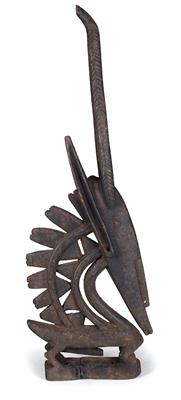Bambara (or Bamana), Mali: an old ‘Chiwara dance crest’, in the form of a male antelope. Style: Ségou region.
Bambara (or Bamana), Mali: an old ‘Chiwara dance crest’, in the form of a male antelope. Style: Ségou region.

‘Chiwara dance crests’ of the Bambara are among the best known and most popular objects of African art. Among the Bambara (also called Bamana), workers of the land in the Mali savanna, two young men dance with such antelope crests, known as ‘Chiwara’ (also ‘Chi-wara’), on their heads and wearing floor-length, black costumes of fibres. The aim of the ritual is to increase and secure fertility. During the dance, the ‘Chiwara’ are fixed on to plaited caps.
The present antelope crest is a good, old example of the ‘classical’, high and vertical type of a ‘Chiwara’. It depicts a male hippotragus (horse antelope). It is carved from hard brown wood and originally dyed black. With two almost straight horns, only slightly curved at the very top, and carved in relief. With a long, narrow head, the nose pierced (originally for a metal ring or a red cotton tassel). The ears are also long and narrow. They are also pierced at the bottom, equally for the attachment of rings or of decorative tassels. The mane of the hippotragus (horse antelope) is impressively and traditionally fashioned in two sweeping arches with openwork spikes. The head, the mane and the body bear linear and small, triangular chip-carving decorations. The base on which the antelope stands is pierced in four places, for tying the dance crest onto the plaited cap of the dancer. A stylistically perfect, old example of this type of dance crest, in the style of the Ségou region on the Niger river, in the northern settlement area of the Bambara. With minor damage due to age: the outer pointed ends of both horns are broken off (with remains of an old original repair), the base has already been broken through (glued), as well as a few, minimal, slight cracks on the base, legs, body, mane and neck of the antelope. For all this, the present object displays good, old traces of use and a black, encrusted and shiny patina. Height: 83 cm. First half of the 20th century. (ME)
Provenance:
Hungarian private collection.
Lit.:
‘Bamana. Afrikanische Kunst aus Mali’ by Jean-Paul Colleyn, catalogue of the Rietberg Museum, Zurich, ill. 185, 187, 188, 189, 190, 191, 192.
Esperto: Prof. Erwin Melchardt
 Prof. Erwin Melchardt
Prof. Erwin Melchardt
+43-1-515 60-465
erwin.melchardt@dorotheum.at
20.02.2017 - 14:00
- Prezzo realizzato: **
-
EUR 1.250,-
- Prezzo di partenza:
-
EUR 800,-
Bambara (or Bamana), Mali: an old ‘Chiwara dance crest’, in the form of a male antelope. Style: Ségou region.
‘Chiwara dance crests’ of the Bambara are among the best known and most popular objects of African art. Among the Bambara (also called Bamana), workers of the land in the Mali savanna, two young men dance with such antelope crests, known as ‘Chiwara’ (also ‘Chi-wara’), on their heads and wearing floor-length, black costumes of fibres. The aim of the ritual is to increase and secure fertility. During the dance, the ‘Chiwara’ are fixed on to plaited caps.
The present antelope crest is a good, old example of the ‘classical’, high and vertical type of a ‘Chiwara’. It depicts a male hippotragus (horse antelope). It is carved from hard brown wood and originally dyed black. With two almost straight horns, only slightly curved at the very top, and carved in relief. With a long, narrow head, the nose pierced (originally for a metal ring or a red cotton tassel). The ears are also long and narrow. They are also pierced at the bottom, equally for the attachment of rings or of decorative tassels. The mane of the hippotragus (horse antelope) is impressively and traditionally fashioned in two sweeping arches with openwork spikes. The head, the mane and the body bear linear and small, triangular chip-carving decorations. The base on which the antelope stands is pierced in four places, for tying the dance crest onto the plaited cap of the dancer. A stylistically perfect, old example of this type of dance crest, in the style of the Ségou region on the Niger river, in the northern settlement area of the Bambara. With minor damage due to age: the outer pointed ends of both horns are broken off (with remains of an old original repair), the base has already been broken through (glued), as well as a few, minimal, slight cracks on the base, legs, body, mane and neck of the antelope. For all this, the present object displays good, old traces of use and a black, encrusted and shiny patina. Height: 83 cm. First half of the 20th century. (ME)
Provenance:
Hungarian private collection.
Lit.:
‘Bamana. Afrikanische Kunst aus Mali’ by Jean-Paul Colleyn, catalogue of the Rietberg Museum, Zurich, ill. 185, 187, 188, 189, 190, 191, 192.
Esperto: Prof. Erwin Melchardt
 Prof. Erwin Melchardt
Prof. Erwin Melchardt
+43-1-515 60-465
erwin.melchardt@dorotheum.at
|
Hotline dell'acquirente
lun-ven: 10.00 - 17.00
kundendienst@dorotheum.at +43 1 515 60 200 |
| Asta: | Tribal Art |
| Tipo d'asta: | Asta in sala |
| Data: | 20.02.2017 - 14:00 |
| Luogo dell'asta: | Wien | Palais Dorotheum |
| Esposizione: | 11.02. - 20.02.2017 |
** Prezzo d'acquisto comprensivo di tassa di vendita e IVA
Non è più possibile effettuare un ordine di acquisto su Internet. L'asta è in preparazione o è già stata eseguita.
